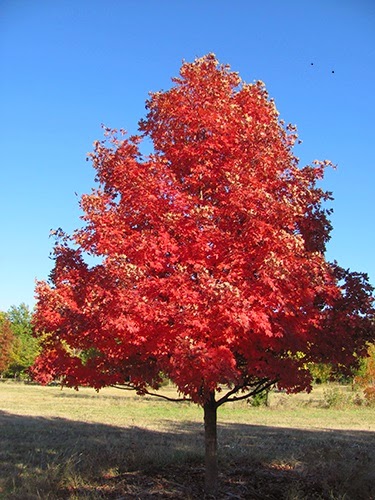Sudden Oak Death in Kansas
Cassie Homan, Horticulture Agent
 Sudden Oak Death is not new to the United States, but
this is the first time that it has been reported in Kansas. The disease has
caused damage in susceptible trees for nearly 15 years, especially in
California, Washington and Oregon.
Sudden Oak Death is not new to the United States, but
this is the first time that it has been reported in Kansas. The disease has
caused damage in susceptible trees for nearly 15 years, especially in
California, Washington and Oregon.
 “Unfortunately,” he adds, “few details are certain
about how this pathogen might affect the species that are native to our central
hardwood forests, so we encourage the public to be proactive in taking steps to
ensure this disease does not spread from rhododendrons or other infested plant
material into our community forests and rural woodlands.”
“Unfortunately,” he adds, “few details are certain
about how this pathogen might affect the species that are native to our central
hardwood forests, so we encourage the public to be proactive in taking steps to
ensure this disease does not spread from rhododendrons or other infested plant
material into our community forests and rural woodlands.”
This news release
from K-State Research and Extension is posted online at https://www.ksre.k-state.edu/news/stories/2019/06/Sudden-Oak-Death-Reported-in-Kansas.html
Kansas State University plant disease and horticulture
experts are urging Kansans to be on the lookout for a disease that threatens
oak trees and other susceptible plants, and has now been reported to be in the
state.
The Kansas Department of Agriculture announced on June
7 that the pathogen that causes Sudden Oak Death, called Phytophthora
ramorum, was found in rhododendron container plants. The
plants are part of a shipment distributed to Walmart stores in Kansas and one
Home Depot store in Pittsburg from a supplier in Oklahoma.
Information from KDA can be found at https://www.agriculture.ks.gov/SOD.
 Sudden Oak Death is not new to the United States, but
this is the first time that it has been reported in Kansas. The disease has
caused damage in susceptible trees for nearly 15 years, especially in
California, Washington and Oregon.
Sudden Oak Death is not new to the United States, but
this is the first time that it has been reported in Kansas. The disease has
caused damage in susceptible trees for nearly 15 years, especially in
California, Washington and Oregon.
Kansas oak forests are primarily located in the eastern
third of the state. Red oaks are the only sub-group that is affected by Phytophthora
ramorum.
“It can also infect a broad range of nursery plants at
which point it is referred to as a Ramorum blight,” said
Cheryl Boyer, a nursery crop production specialist with K-State Research and
Extension.
Ryan Armbrust, the health and conservation forester
with the Kansas Forest Service, said that the state’s oak forests are primarily
located in the eastern third of the state and “most native oaks like bur
oak are of the potentially less-susceptible white oak group, but there are
millions of red, black, pin, shumard, blackjack, shingle, and other oaks that
could be impacted should this disease gain a foothold in the state.”
 “Unfortunately,” he adds, “few details are certain
about how this pathogen might affect the species that are native to our central
hardwood forests, so we encourage the public to be proactive in taking steps to
ensure this disease does not spread from rhododendrons or other infested plant
material into our community forests and rural woodlands.”
“Unfortunately,” he adds, “few details are certain
about how this pathogen might affect the species that are native to our central
hardwood forests, so we encourage the public to be proactive in taking steps to
ensure this disease does not spread from rhododendrons or other infested plant
material into our community forests and rural woodlands.”
According to K-State plant pathologist Megan
Kennelly, P. ramorum causes bleeding cankers on the trunk of
oak trees, leading to a decline of the tree. Underneath the bark, the cankers
have defined margins with a reddish-brown color.
Kennelly noted that on nursery plants, the symptoms are
leaf spotting or browning and sometimes a stem dieback. The symptoms can be
confused with common problems such as sunscald. P. ramorum rarely
causes death of nursery plants.
“The Phytophthora diseases are called water molds and
they are triggered by wet conditions,” Kennelly said. “Kansas has had
significant rain this spring, so conditions have been favorable for the
disease.”
She noted that the likelihood of P. ramorum moving
into western Kansas oak plantings is much less because that region is more dry
than the eastern half of the state, “but there is still a risk,” she said.
Officials at K-State and the KDA say that as a
precaution, homeowners who purchased a rhododendron at Walmart or the Home
Depot in Pittsburg this spring should immediately dig up the plant (including
the root ball), double bag it in plastic and dispose of it in the garbage.
Garden tools and shoes or boots that come into the
contact with the plant or its root ball soil should be sanitized before using
them in other areas of the landscape.
The U.S. Department of Agriculture’s Animal and Plant
Health Inspection Service maintains the most current list of plants that are susceptible to Sudden Oak Death.
If you suspect you have Sudden Oak Death in your
landscape, please contact your local Post Rock District Extension Office.








